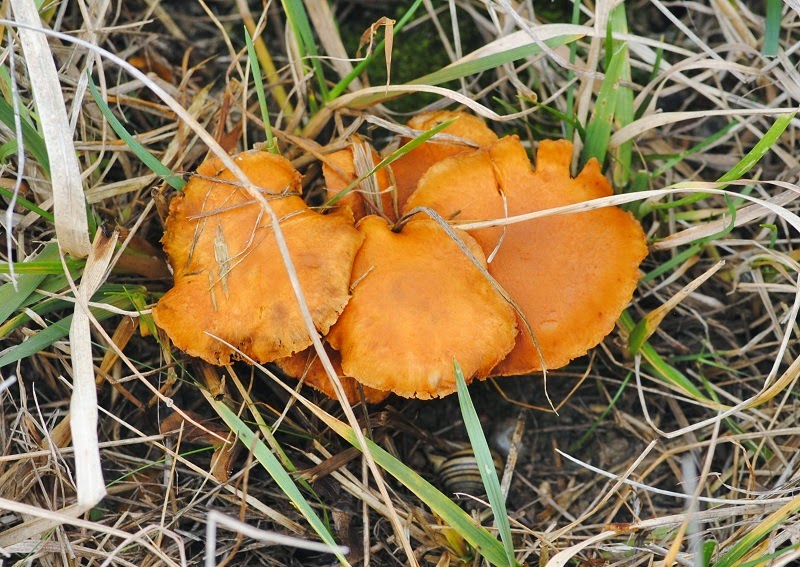Guest Author: Nick Aplin
Sussex Fungi Group: 18th October 2014
Brown Cup (Rutstroemia firma)
It was a dull and overcast morning on our first visit to
Brockley Wood, but several of us were optimistic that the recent wet weather
would bring out some interesting species. Finding fungi can sometimes be a
fruitless exercise and the start of the season had certainly been quite patchy
in many respects.
Our route - Brockley Wood in the North West Zone
Initially, we spent some time searching the grassland north
of the runway, where we found a few species associated with buried wood and
other debris, namely Lacrymaria
lacrymabunda The Weeping Widow, Gymnopilus junonius Spectacular Rustgill, Coprinus comatus Shaggy Inkcap and Pholiota gummosa Sticky Scalycap.
Spectacular Rustgill (Gymnopilus junonius)
(Coprinellus domesticus) Firerug Inkcap
A large pile of rotting wood and roots yielded several small
and common species including Hypholoma
fasciculare Sulphur Tuft, Coprinellus domesticus Firerug Inkcap and Mycena adscendens Frosty
Bonnet.
The delicately beautiful Bark Bonnet (Mycena speirea)
I had hopes that we’d see a few of the species which are
indicators of unimproved grassland as we began climbing the path to the south east of Brockley Wood. True to form, we were greeted with our first rarity; the
lovely but understated Arrhenia
griseopallida, a species which seems to favour short turf and fairly
exposed locations.
Arrhenia griseopallida
Although it was perhaps a little too early for Waxcaps, we
also found two Entoloma species which
are also unimproved meadow specialists, E.sericeum
and E.sericellum, the latter growing on a very steep slope and
proving very difficult to photograph!
Extreme-fungi photographing: Entoloma sericellum
‘LBJ’ (=little brown job) is an acronym that was, I think,
created by birders but a term that we often ‘borrow’ to describe certain
cryptic, anonymous-looking brown mushrooms.
Many mycologists don’t like LBJ’s, but some (like me!) take
great interest in them. Good job, too, as we stumbled upon several as we
entered Brockley Wood. The first three were Cortinarius
species, a genus of mushrooms which like to grow in a special symbiosis (called
a mycorrhiza) with tree roots, the tree and the fungus effectively ‘swapping’
nutrients to benefit both parties.
The first, Cortinarius
decipiens Sepia Webcap, grows on the outskirts of the Wood,
mycorrhizal with Willows.
Sepia Webcap (Cortinarius decipiens)
The other two species seemed mycorrhizal with the same Oak
tree. The rebellious Cortinarius vernus
Spring Webcap clearly didn’t want to
live up to its name. Interestingly, the majority of the UK records of this
species are autumnal, so perhaps we should think up a new name? The Germans
apparently call it ‘Pink Stalk’ so I
might go with that, considering the colours at the bottom of the stem…Yes, Pinkstalk Webcap. Let’s go with that.
Pinkstalk Webcap (Cortinarius vernus)
The third species, Cortinarius
psammocepalus, was a nice surprise and seems to be very rarely recorded,
with only a dozen or so UK records. I can’t find a ‘common name’ for this one,
so I’m tempted to go along with the beautifully descriptive Latin epithet and
call it Sandhead Webcap. Oooh yes,
that’s even nicer than my last made-up name.
Sandhead Webcap (Cortinarius psammocepalus)
Ash trees are apparently incapable of supporting any
mycorrizal symbiosis with the larger fungi but to make up for it, they provide
a very nice habitat for saprotrophic species after they die.
As there is plenty of dead Ash wood in Brockley Wood, it was
no surprise that we recorded several species fruiting on it.
Simocybe centunculus
Coniophora puteana Wet Rot
Another obscure
LBJ; Simocybe centunculus, and the crustose
Coniophora puteana Wet Rot were put to shame by a
beautifully coloured but tiny fungus Crepidotus cinnabarinus (strange
that this one has no common name either!), first recorded in 1995,
probably as an introduction. The increase of reports in recent years seems to
suggest that the species is spreading.
The tiny, yet striking Crepidotus cinnabarinus
On our way back to the meeting point, we discovered several
fruiting bodies of a Bird’s Nest Fungus, Crucibulum
laeve, fruiting on and around the base of various dead herb stems. A cheerful sight to end the day!
Bird’s Nest Fungus, (Crucibulum laeve)
Lacrymaria lacrymabunda
Leucoagaricus leucothites
Datronia mollis
Trametes versicolor
Mycena adscendens
Coprinellus domesticus
Phlebia radiata
Mycena speirea
Hypholoma fasciculare
Coprinellus disseminatus
Melanotus horizontalis
Lycogala terrestre
Crepidotus mollis
Lasiosphaeria ovina
Panaeolus semiovatus
Coprinus comatus
Marasmiellus ramealis
Crepidotus cinnabarinus
Parasola leiocephala
Mycena galericulata
Pluteus cervinus
Scleroderma citrinum
Gymnopus fusip es
Schizopora paradoxa
Tubaria furfuracea
Psathyrella microrhiza
Xylaria hypoxylon
Auricularia auricula-judae
Lycoperdon perlatum
Gymnopilus junonius
Crucibulum leave
Coprinopsis lagopus
Clitocybe rivulosa
Entoloma sericellum
Arrhenia griseopallida
Simocybe centunculus var.centunculus
Mycena flavescens
Mycena aetites
Pholiota gummosa
Crepidotus variabilis
Cortinarius psammocephalus
Cortinarius decipiens
Coniophora puteana
Cortinarius vernus
Rutstroemia firma
Rutstroemia firma

















.JPG)









